Strong Interactions between Austenite and the Matrix of Medium-Mn Steel during Intercritical Annealing
Abstract
:1. Introduction
2. Experimental Procedures
3. Results
3.1. Microstructure Change before Intercritical Annealing
3.2. Microstructure of the Samples Annealed for Different Times
3.3. Microstructure of the Samples Annealed at Different Temperatures
4. Discussion
4.1. Ferrite Recrystallization and Formation of Austenite
4.2. Factors that Influenced the Austenite Grain Size
- With increasing annealing time and temperature, the maximum grain size of austenite grains increases significantly.
- The austenite grain size at low-angle grain boundaries was always small.
- The austenite grain size was relatively uniform under low-temperature (650 °C) annealing conditions.
5. Conclusions
- During the annealing process of the cold-rolled medium-Mn steel, the recrystallization of the ferrite matrix provided favorable conditions for the nucleation and growth of the austenite, while the presence of austenite delayed the overall kinetics of recrystallization, thus inhibiting the continuous recrystallization process.
- The high- and low-angle grain boundaries in the matrix provided sites for austenite nucleation, which was related to the recrystallization of the ferrite matrix. However, austenite grains formed at the low-angle grain boundaries always maintained a strict KS OR with the ferrite matrix, so the growth of the austenite was restrained, and the grain size was decreased during intercritical annealing.
- The existence of carbides reduced the kinetics of the austenite growth, so it was difficult for the austenite to grow at low annealing temperatures, regardless of whether there was a strict KS OR between it and the matrix. With increasing annealing temperature, the austenite grains had a non-strict KS OR with the ferrite matrix and grew rapidly.
Author Contributions
Funding
Acknowledgments
Conflicts of Interest
References
- Suh, D.W.; Kim, S.J. Medium Mn transformation-induced plasticity steels: Recent progress and challenges. Scr. Mater. 2017, 126, 63–67. [Google Scholar] [CrossRef]
- Yan, S.; Liu, X.H.; Liang, T.S.; Zhao, Y. The effects of the initial microstructure on microstructural evolution, mechanical properties and reversed austenite stability of intercritically annealed Fe-6.1Mn-1.5Si-0.12C steel. Mater. Sci. Eng. A 2018, 712, 332–340. [Google Scholar] [CrossRef]
- Morawiec, M.; Grajcar, A.; Zalecki, W.; Garcia-Mateo, C.; Opiela, M. Dilatometric Study of Phase Transformations in 5Mn Steel Subjected to Different Heat Treatments. Materials 2020, 13, 958. [Google Scholar] [CrossRef] [PubMed] [Green Version]
- Miller, R.L. Ultrafine-grained microstructures and mechanical properties of alloy steels. Metall. Mater. Trans. B 1972, 3, 905–912. [Google Scholar] [CrossRef]
- Niikura, M.; Morris, J.W. Thermal processing of ferritic 5 Mn steel for toughness at cryogenic temperatures. Metall. Trans. A 1980, 11, 1531–1540. [Google Scholar] [CrossRef]
- Han, J.; Lee, S.J.; Lee, C.Y.; Lee, S.; Jo, S.Y.; Lee, Y.K. The size effect of initial martensite constituents on the microstructure and tensile properties of intercritically annealed Fe–9Mn–0.05C steel. Mater. Sci. Eng. A 2015, 633, 9–16. [Google Scholar] [CrossRef]
- Luo, H.W.; Dong, H.; Huang, M.X. Effect of intercritical annealing on the Lüders strains of medium Mn transformation-induced plasticity steels. Mater. Des. 2015, 83, 42–48. [Google Scholar] [CrossRef]
- Kamoutsi, H.; Gioti, E.; Haidemenopoulos, G.N.; Cai, Z.; Ding, H. Kinetics of solute partitioning during intercritical annealing of a medium-Mn steel. Metall. Mater. Trans. A 2015, 46, 4841–4846. [Google Scholar] [CrossRef]
- Cai, Z.H.; Ding, H.; Kamoutsi, H.; Haidemenopoulos, G.N.; Misra, R.D.K. Interplay between deformation behavior and mechanical properties of intercritically annealed and tempered medium-manganese transformation-induced plasticity steel. Mater. Sci. Eng. A 2016, 654, 359–367. [Google Scholar] [CrossRef]
- Luo, X.N.; Zhong, X.Y.; Luo, H.W.; Zhou, H.H.; Wang, C.Y.; Shi, J. Mn Diffusion at Early Stage of Intercritical Annealing of 5Mn Steel. J. Iron Steel Res. Int. 2015, 22, 1015–1019. [Google Scholar] [CrossRef]
- de Lacalle, L.N.L.; Lamikiz, A.; Muñoa, J.; Salgado, M.A.; Sánchez, J.A. Improving the high-speed finishing of forming tools for advanced high-strength steels (AHSS). Int. J. Adv. Manuf. Technol. 2006, 29, 49–63. [Google Scholar] [CrossRef]
- Chbihi, A.; Barbier, D.; Germain, L.; Hazotte, A.; Gouné, M. Interactions between ferrite recrystallization and austenite formation in high-strength steels. J. Mater. Sci. 2014, 49, 3608–3621. [Google Scholar] [CrossRef]
- Yang, D.Z.; Brown, E.L.; Matlock, D.K.; Krauss, G. Ferrite recrystallization and austenite formation in cold-rolled intercritically annealed steel. Metall. Trans. A 1985, 16, 1385–1392. [Google Scholar] [CrossRef]
- Zheng, C.W.; Raabe, D. Interaction between recrystallization and phase transformation during intercritical annealing in a cold-rolled dual-phase steel: A cellular automaton model. Acta Mater. 2013, 61, 5504–5517. [Google Scholar] [CrossRef]
- Wang, C.Y.; Shi, J.; Cao, W.Q.; Dong, H. Characterization of microstructure obtained by quenching and partitioning process in low alloy martensitic steel. Mater. Sci. Eng. A 2010, 527, 3442–3449. [Google Scholar] [CrossRef]
- Yen, H.W.; Ooi, S.W.; Eizadjou, M.; Breen, A.; Huang, C.Y.; Bhadeshia, H.K.D.H.; Ringer, S.P. Role of stress-assisted martensite in the design of strong ultrafine-grained duplex steels. Acta Mater. 2015, 82, 100–114. [Google Scholar] [CrossRef] [Green Version]
- Yang, H.S.; Bhadeshia, H. Austenite grain size and the martensite-start temperature. Scr. Mater. 2009, 60, 493–495. [Google Scholar] [CrossRef]
- Chen, J.; Liu, M.Y.; Liu, Z.Y.; Wang, G.D. Influence of heat treatments on the microstructural evolution and resultant mechanical properties in a low carbon medium Mn heavy steel plate. Metall. Mater. Trans. A 2016, 47, 2300–2312. [Google Scholar] [CrossRef]
- Bhadeshia, H.K.D.H. Some phase transformations in steels. Mater. Sci. Technol. 1999, 15, 22–29. [Google Scholar] [CrossRef]
- Moor, E.D.; Kang, S.; Speer, J.G.; Matlock, D.K. Manganese diffusion in third generation advanced high strength steels. In Proceedings of the International Conference on Mining, Material and Metallurgical Engineering, Prague, Czech Republic, 11–12 August 2014. [Google Scholar]
- Mandal, S.; Bhaduri, A.K.; Sarma, V.S. A study on microstructural evolution and dynamic recrystallization during isothermal deformation of a Ti-modified austenitic stainless steel. Metall. Mater. Trans. A 2011, 42, 1062–1072. [Google Scholar] [CrossRef]
- Avrami, M. Granulation, Phase Change, and Microstructure Kinetics of Phase Change. III. J. Chem. Phys. 1941, 92, 177–184. [Google Scholar] [CrossRef]
- Babu, K.A.; Mandal, S.; Athreya, C.N.; Shakthipriya, B.; Sarma, V.S. Hot deformation characteristics and processing map of a phosphorous modified super austenitic stainless steel. Mater. Des. 2017, 115, 262–275. [Google Scholar] [CrossRef]
- Sarkar, A.; Sanyal, S.; Bandyopadhyay, T.K.; Mandal, S. Influence of annealing parameters on phase evolution and recrystallization kinetics of a Mn-Al-Si alloyed duplex steel. Mater. Charact. 2017, 134, 213–224. [Google Scholar] [CrossRef]
- Zhang, X.G.; Miyamoto, G.; Kaneshita, T.; Yoshida, Y.; Toji, Y.; Furuhara, T. Growth mode of austenite during reversion from martensite in Fe-2Mn-1.5Si-0.3C alloy: A transition in kinetics and morphology. Acta Mater. 2018, 154, 1–13. [Google Scholar] [CrossRef]
- Benzing, J.T.; da Silva, A.K.; Morsdorf, L.; Bentley, J.; Ponge, D.; Dutta, A.; Han, J.; McBride, J.R.; Van Leer, B.; Gault, B.; et al. Multi-scale characterization of austenite reversion and martensite recovery in a cold-rolled medium-Mn steel. Acta Mater. 2019, 166, 512–530. [Google Scholar] [CrossRef]
- Gouné, M.; Maugis, P.; Drillet, J. A criterion for the change from fast to slow regime of cementite dissolution in Fe–C–Mn steels. J. Mater. Sci. Technol. 2012, 28, 728–736. [Google Scholar] [CrossRef]
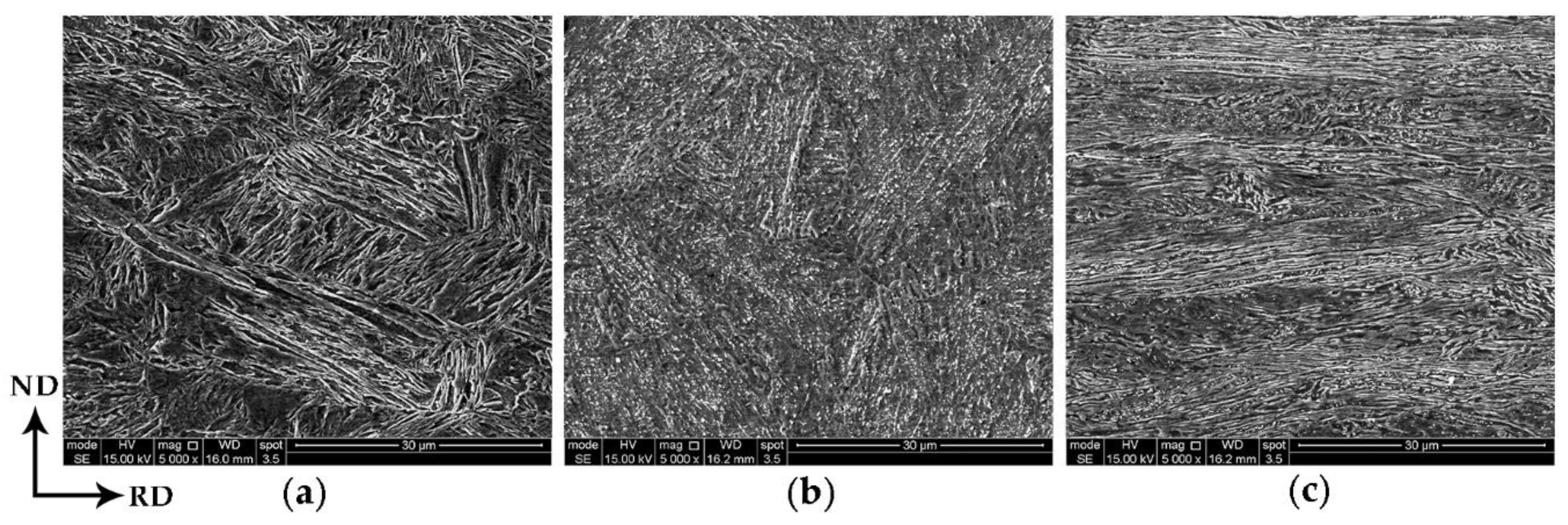
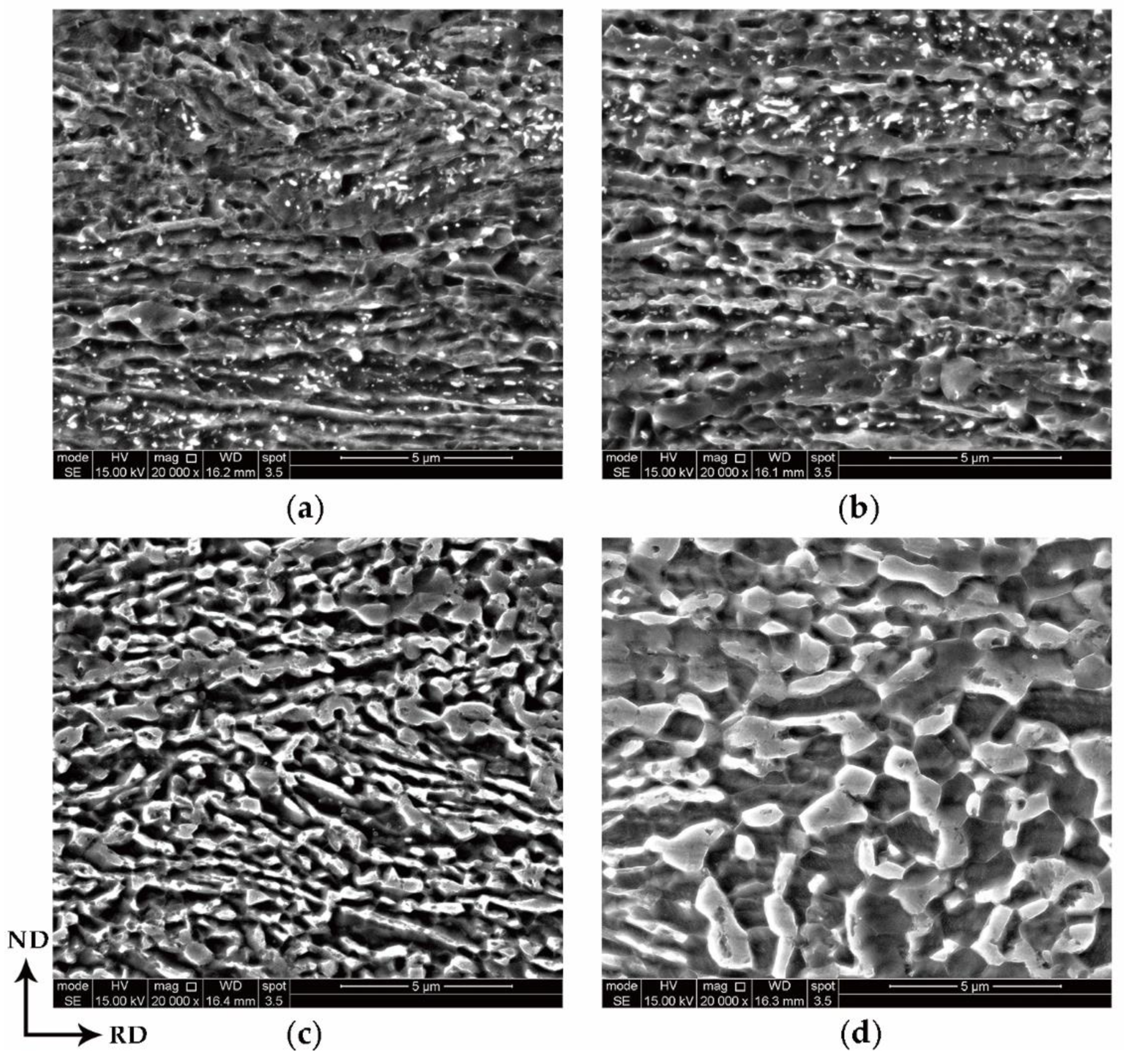

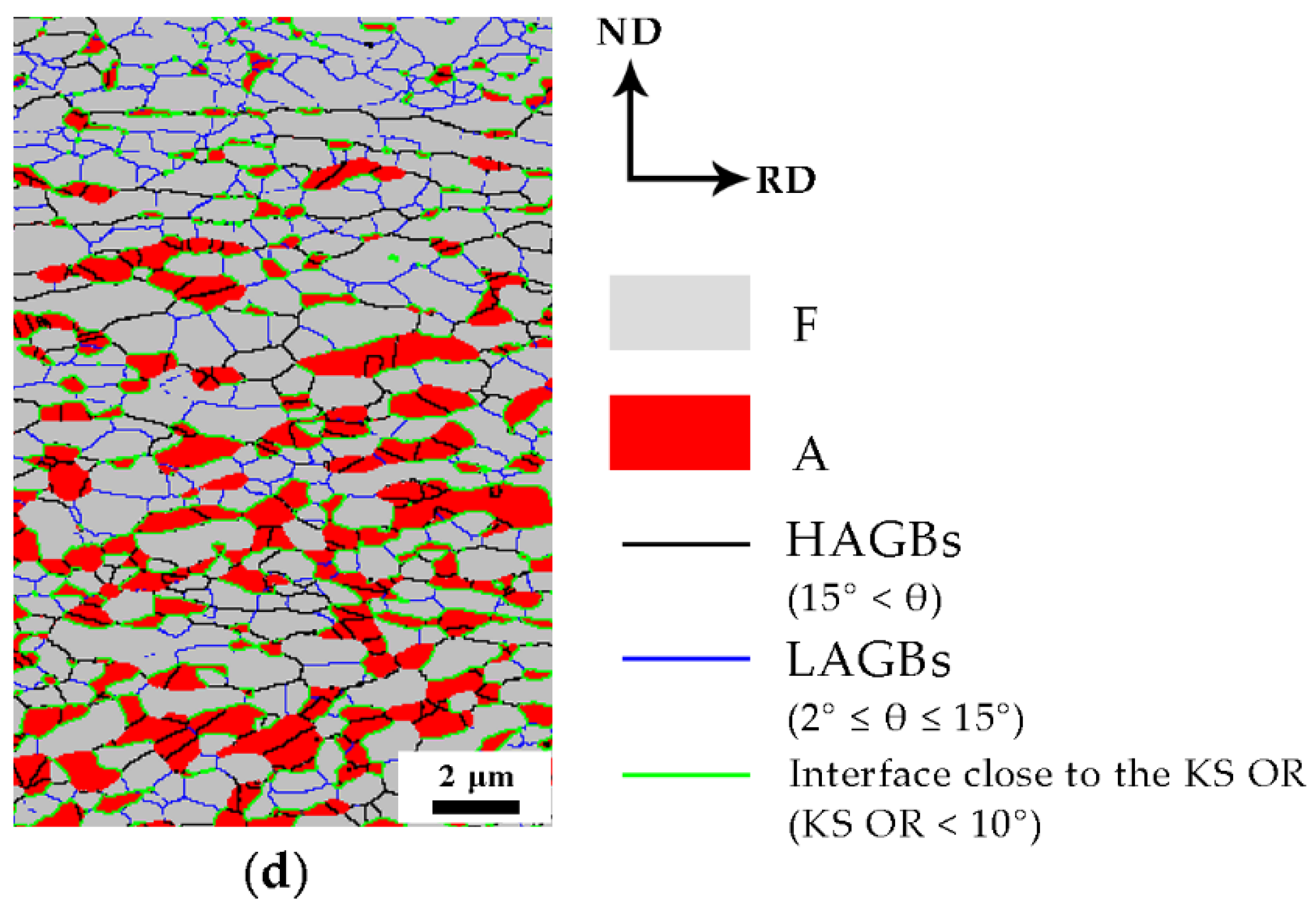
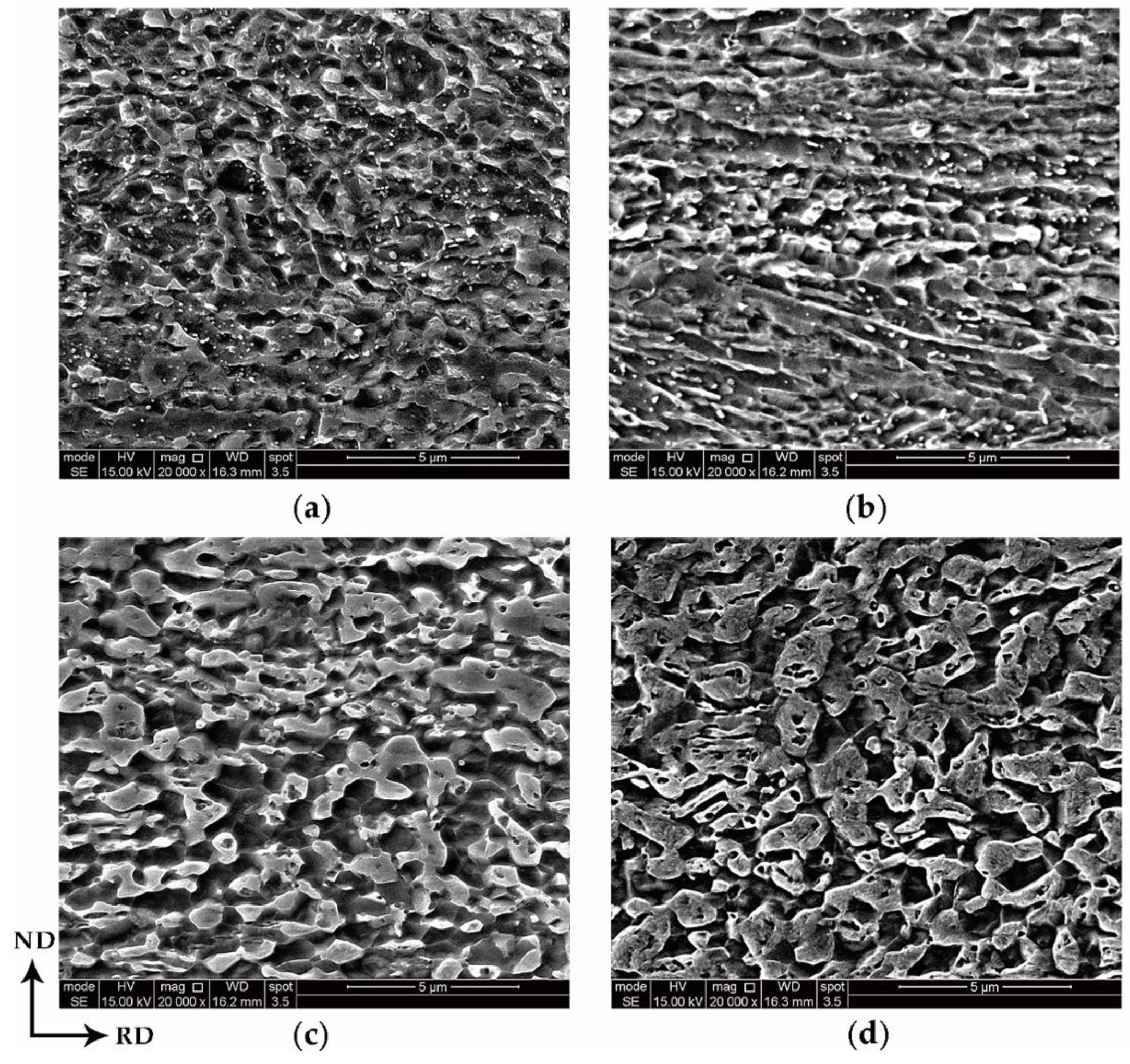
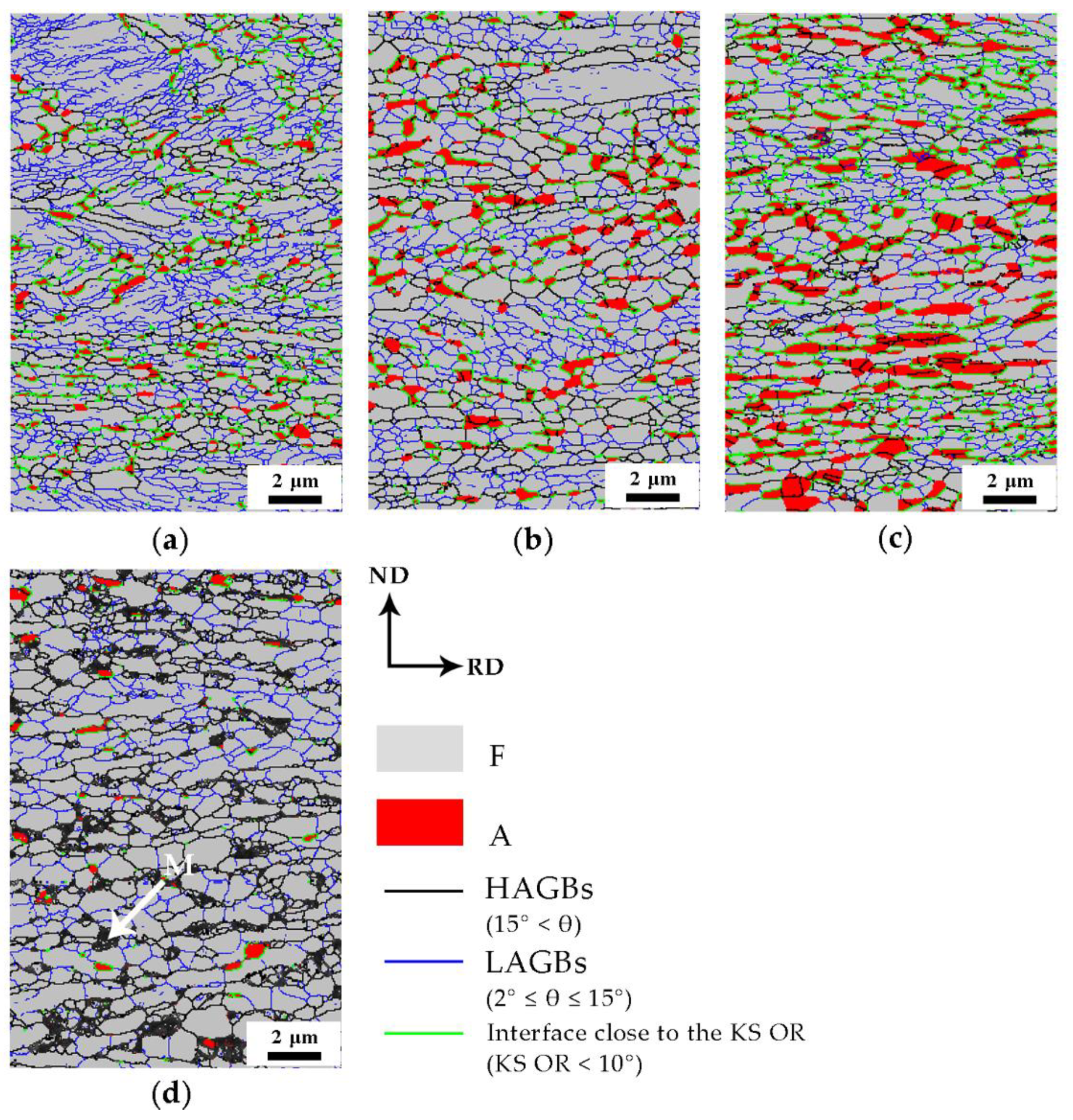
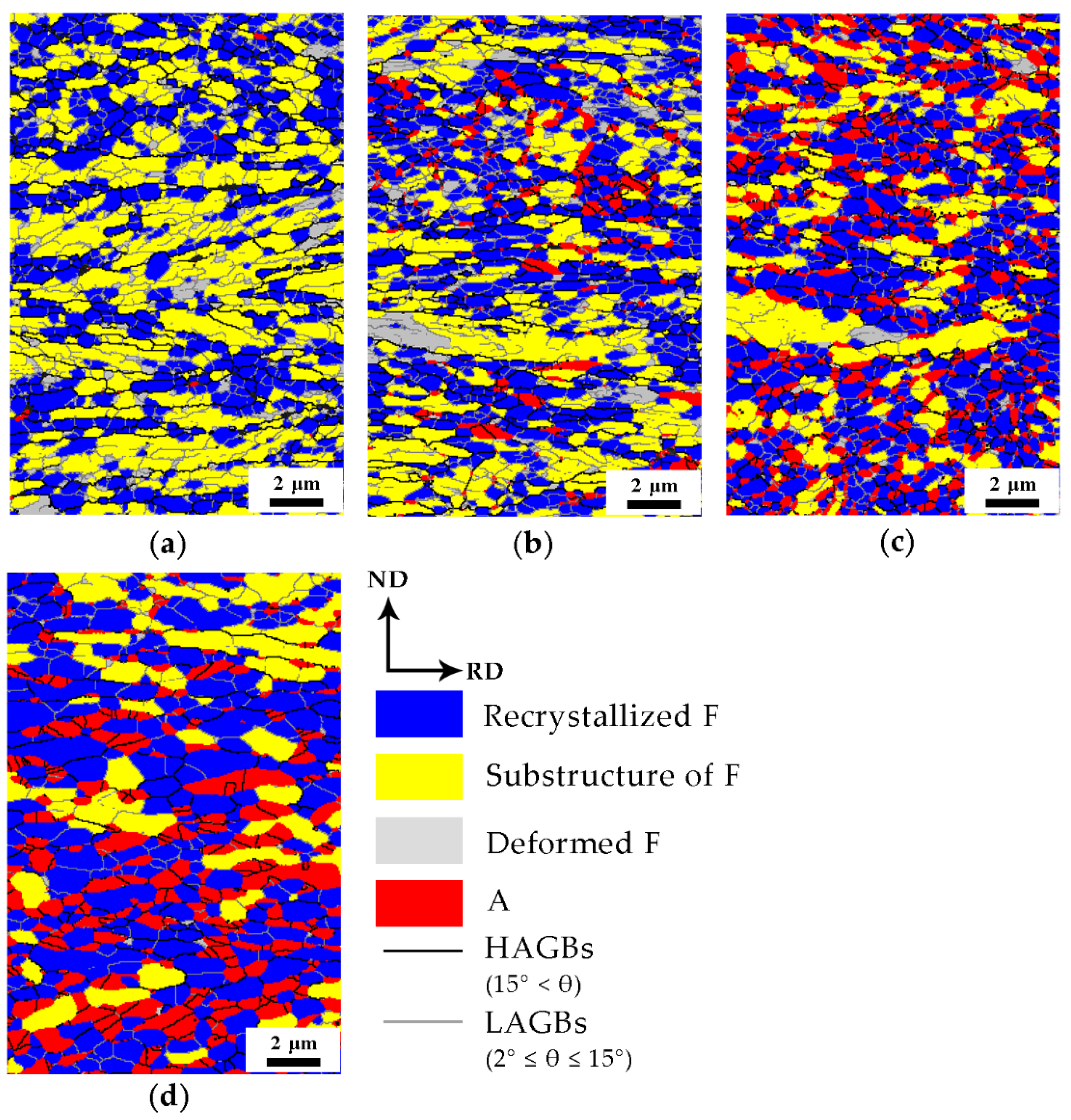

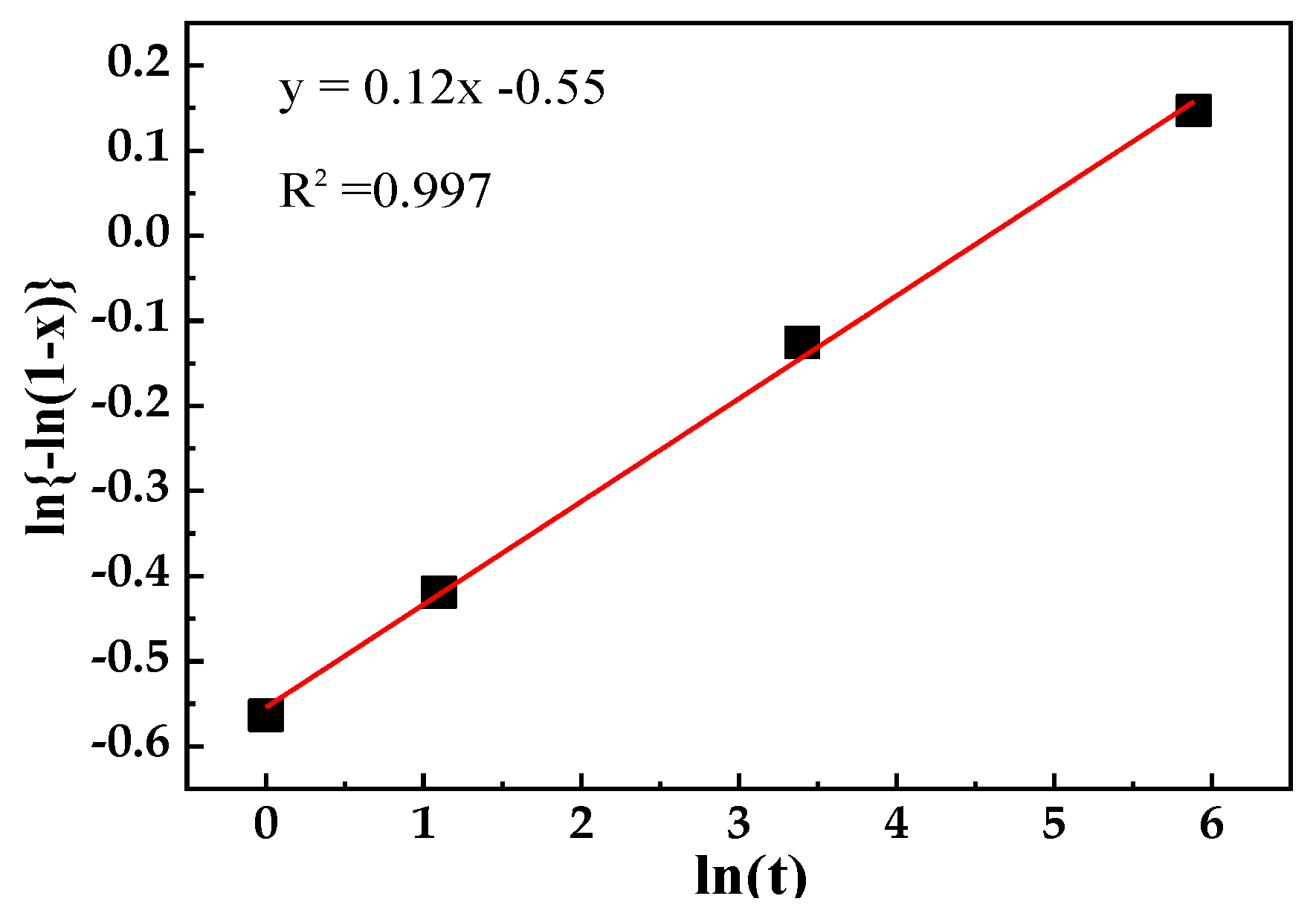
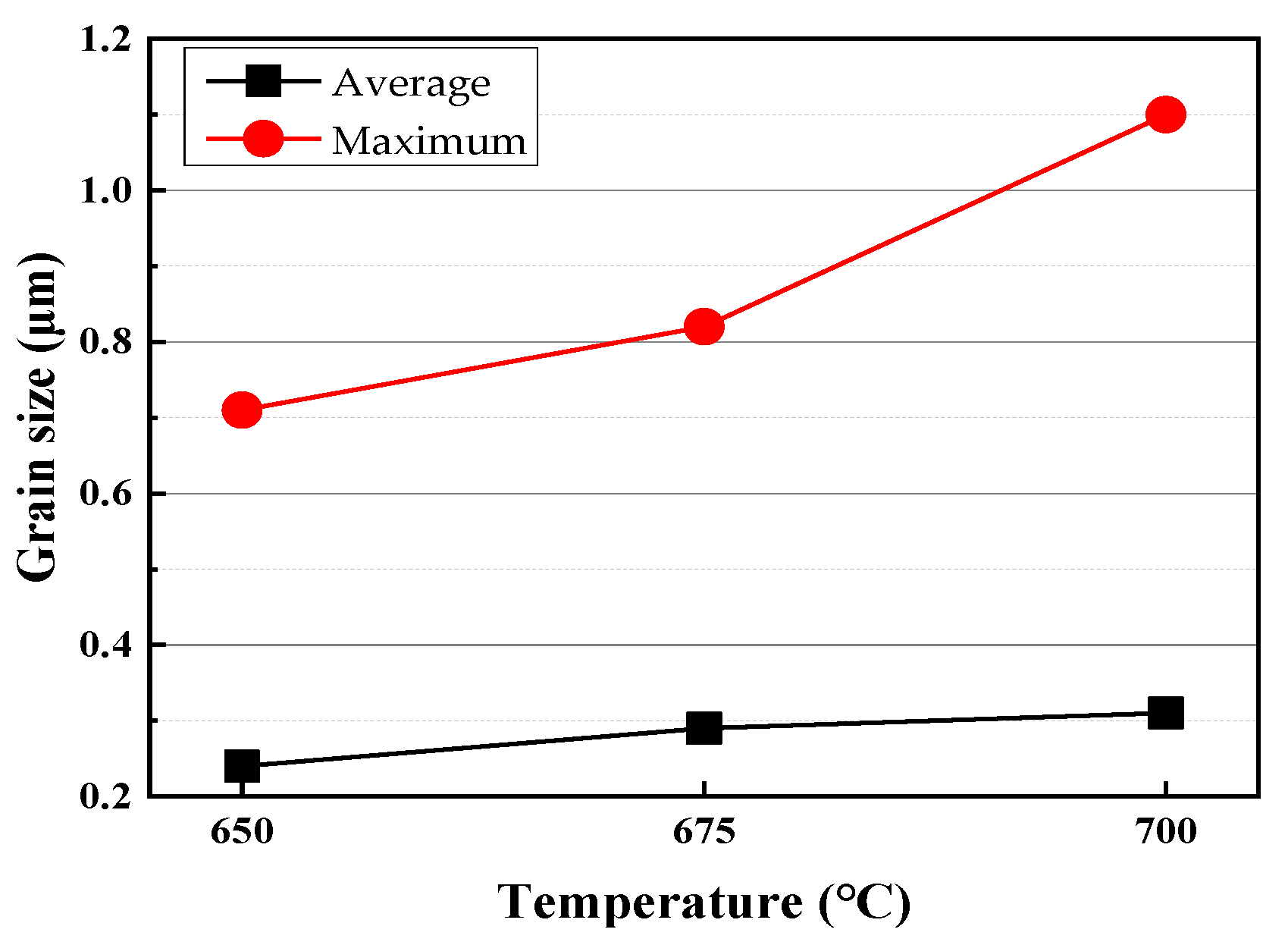
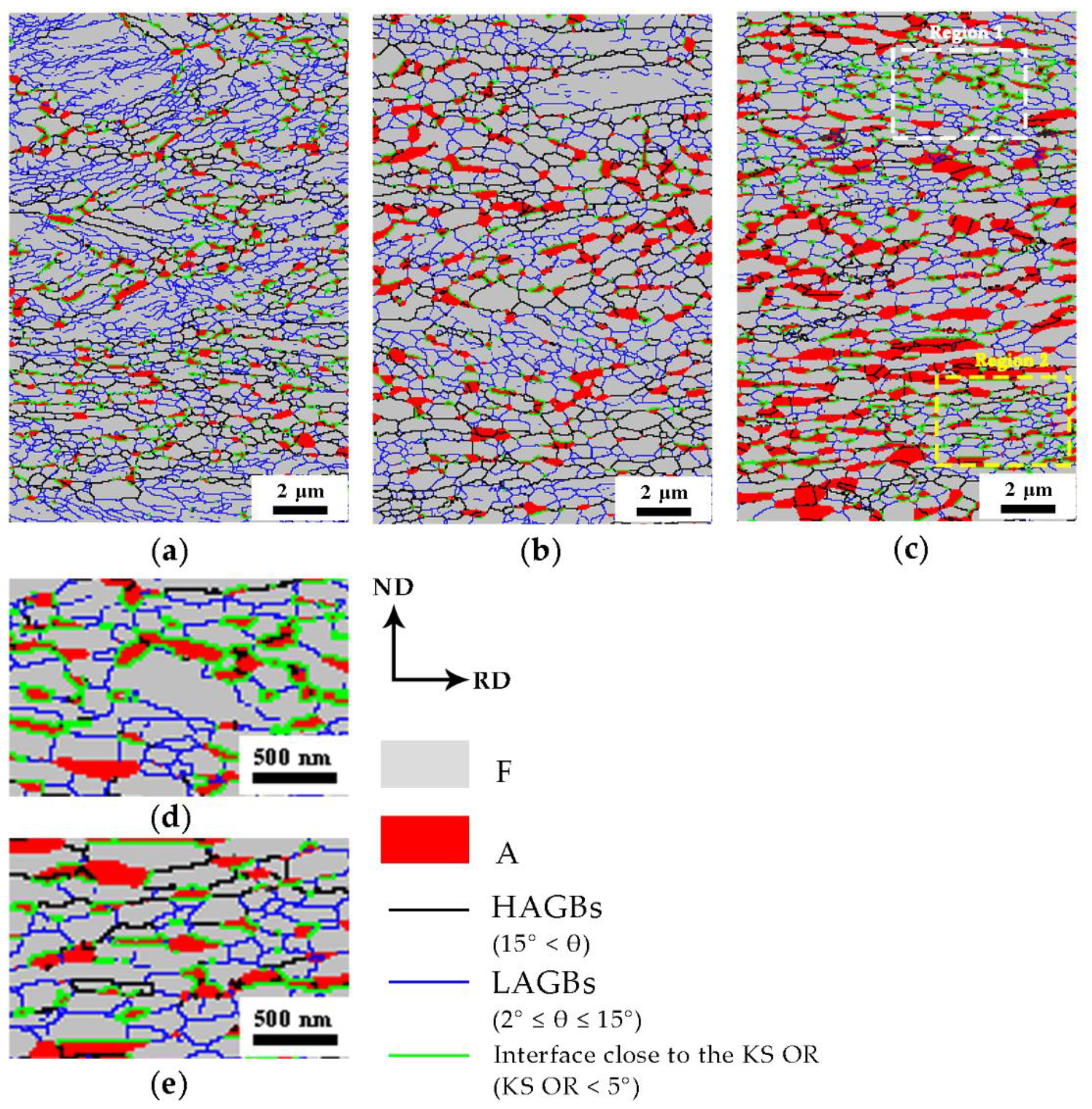
© 2020 by the authors. Licensee MDPI, Basel, Switzerland. This article is an open access article distributed under the terms and conditions of the Creative Commons Attribution (CC BY) license (http://creativecommons.org/licenses/by/4.0/).
Share and Cite
Zhou, T.; Wang, C.; Wang, C.; Cao, W.; Chen, Z. Strong Interactions between Austenite and the Matrix of Medium-Mn Steel during Intercritical Annealing. Materials 2020, 13, 3366. https://doi.org/10.3390/ma13153366
Zhou T, Wang C, Wang C, Cao W, Chen Z. Strong Interactions between Austenite and the Matrix of Medium-Mn Steel during Intercritical Annealing. Materials. 2020; 13(15):3366. https://doi.org/10.3390/ma13153366
Chicago/Turabian StyleZhou, Tianpeng, Cunyu Wang, Chang Wang, Wenquan Cao, and Zejun Chen. 2020. "Strong Interactions between Austenite and the Matrix of Medium-Mn Steel during Intercritical Annealing" Materials 13, no. 15: 3366. https://doi.org/10.3390/ma13153366






